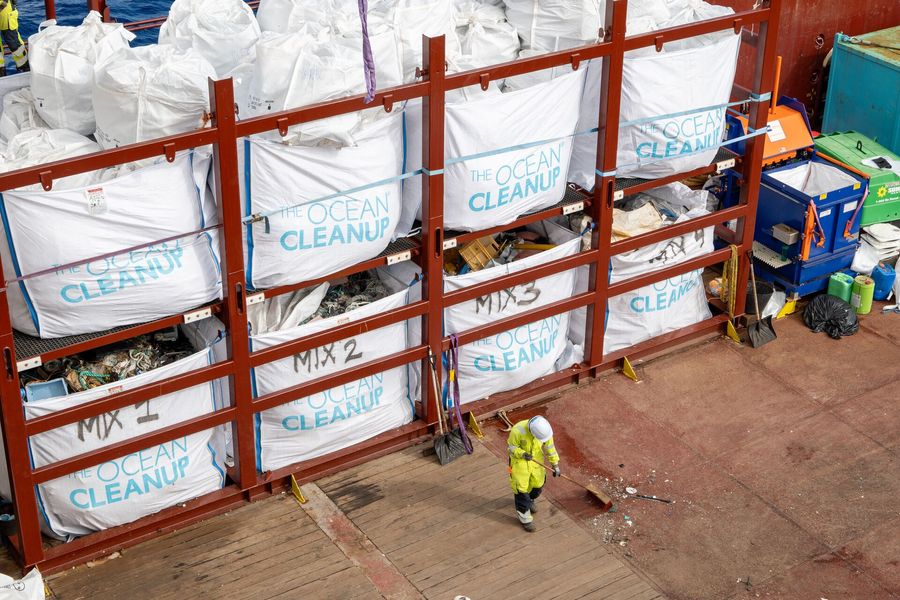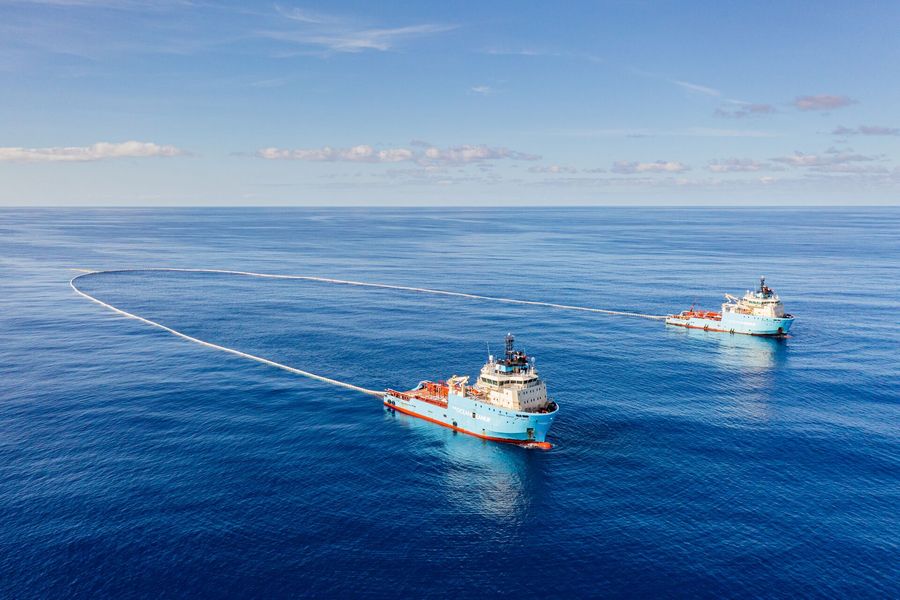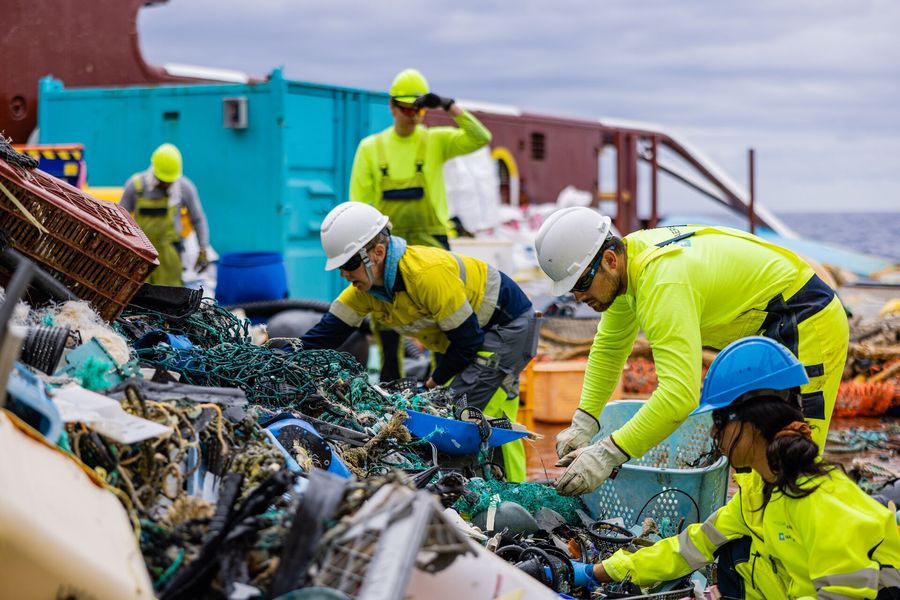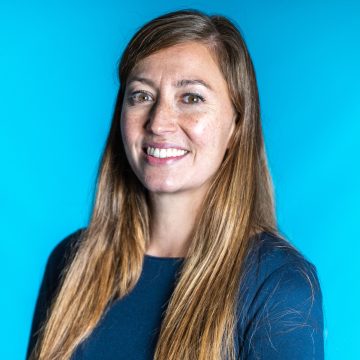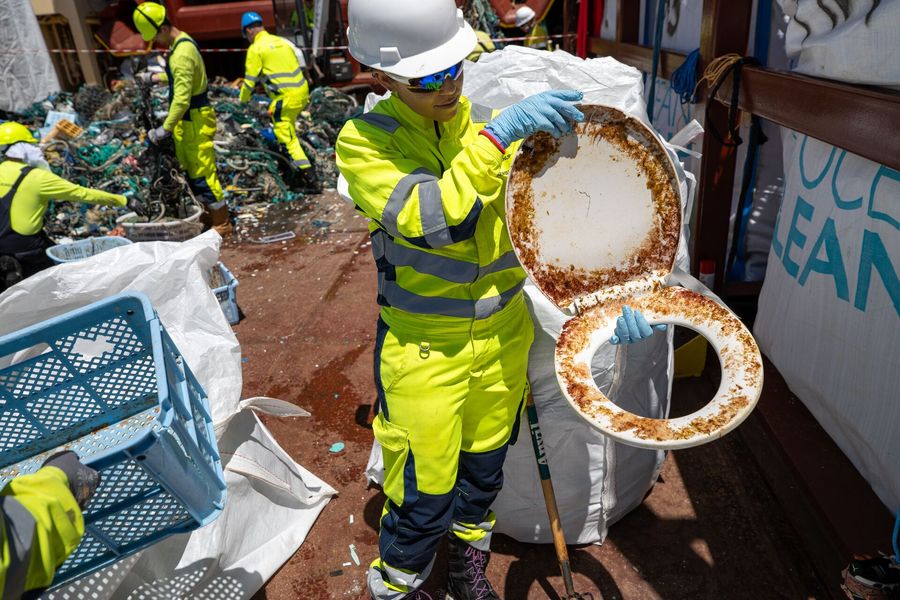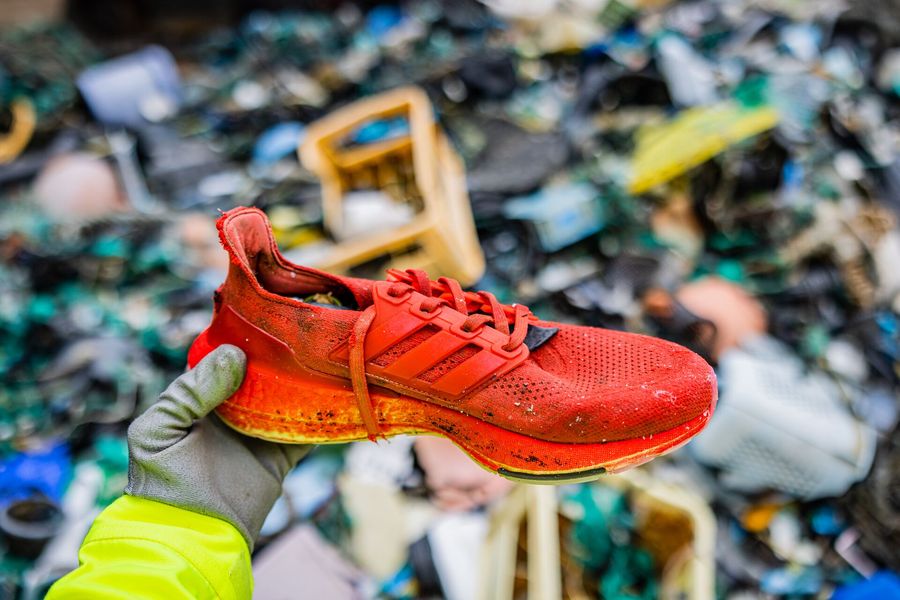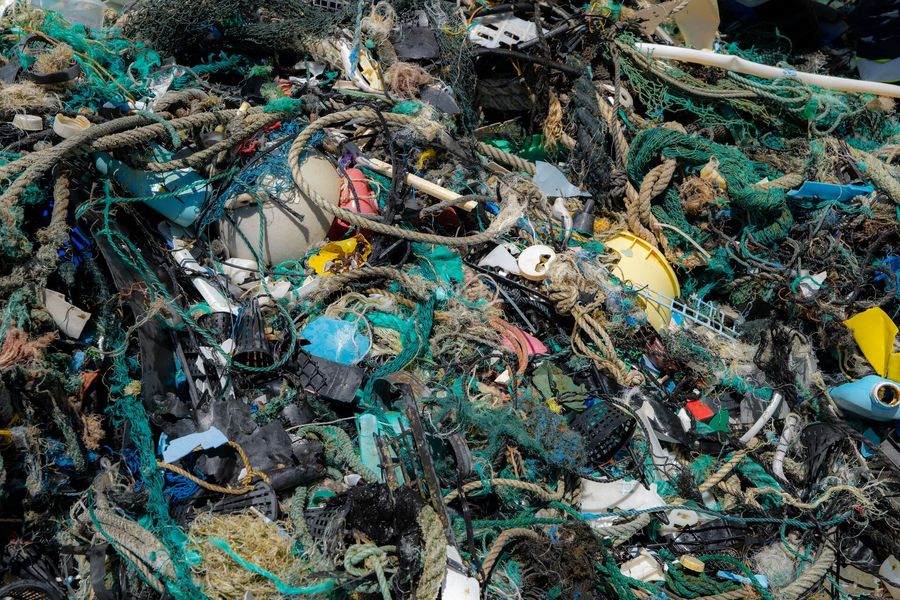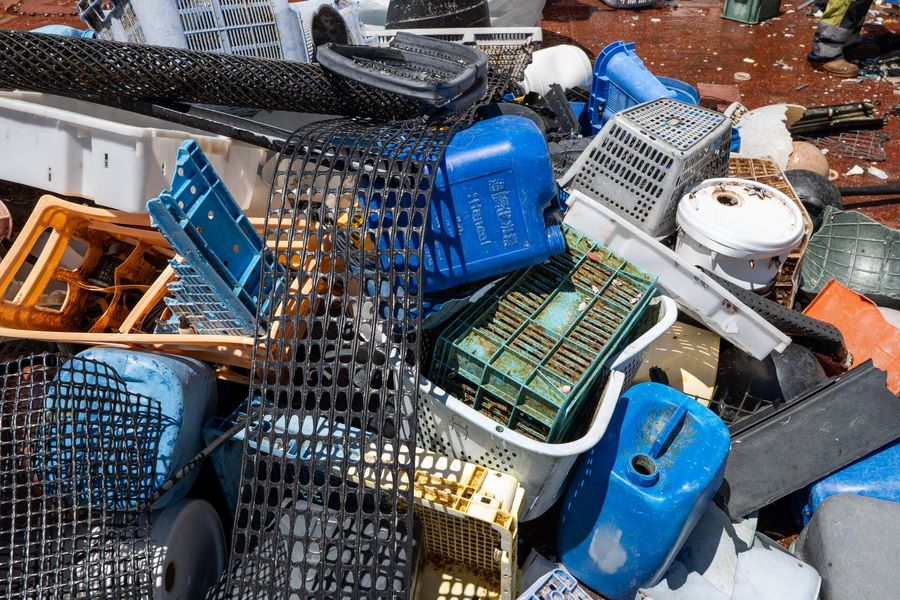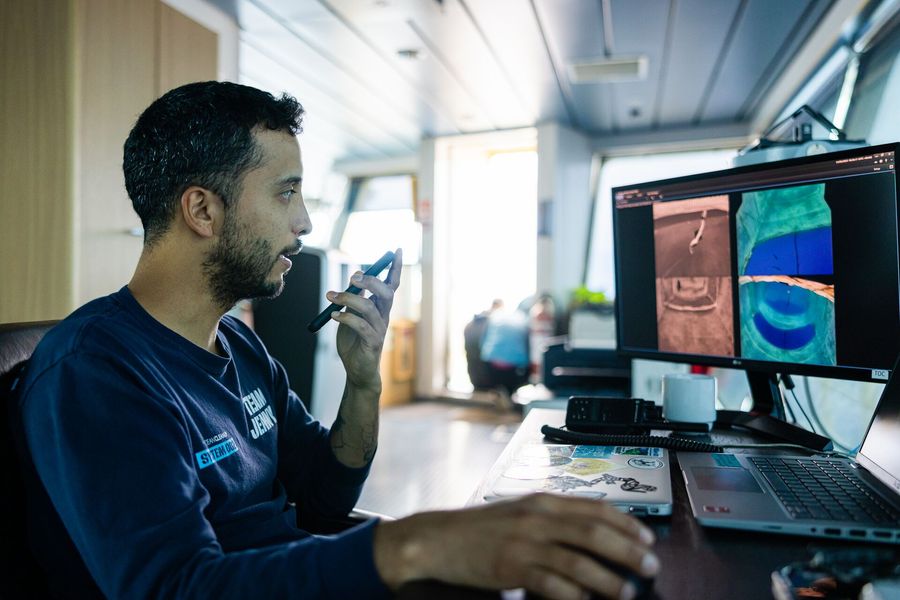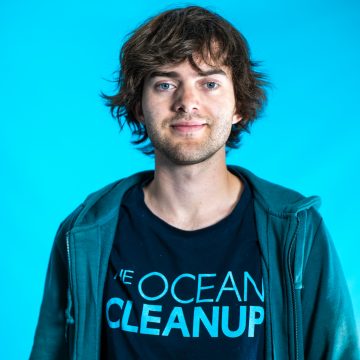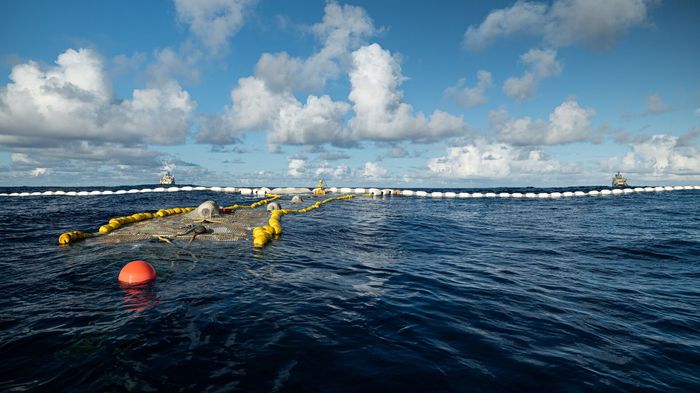
What Jenny Taught Us: Lessons from System 002
Back to updatesOn 21 August 2023, System 002 (or Jenny, as we say) returned to port for the last time as we move to the larger and upgraded System 03.
After two years of service, cleaning an area of 8,352 km2 (over 3,000 square miles) and removing 282,787 kilograms (623,439 lbs) of plastic from the Great Pacific Garbage Patch over dozens of extractions, System 002 arrived at the Port of Victoria, Vancouver, Canada where it was met by Boyan Slat, Founder and CEO of The Ocean Cleanup.
Fittingly for the occasion, we brought back the largest haul of plastic we’ve ever returned to shore, extracted over the final two trips of System 002’s deployment: over 55 tons, allowing System 002 to finish on a high and giving us confidence as we scale up our technology.
System 03 will be bigger, better, and more efficient than System 002 – and will mark the next phase in our mission. The challenges and learnings that we have experienced during System 002’s deployment have been crucial for our progress, and will continue to guide and influence us as System 03 evolves.
System 002 consistently rose to the challenge and allowed us to learn from a range of perspectives: across our operations, catch management, environmental protection measures, and more. We asked a selection of The Ocean Cleanup’s experts about the key lessons they’ve learned from System 002’s years in the GPGP, and what they’re most excited about as we prepare to deploy System 03.
CREW THOUGHTS AND LEARNINGS
JOËL JANSEN
OCEAN DIRETOR
Q: System 002 has come a long way since that first test period – what’s been the biggest learning for you during this time, and how has this affected our operations?
A: It’s been a remarkable period for us in the Oceans team, but when we look at the big picture, our biggest learning is that our technology works, and the ocean can be cleaned. Our mission is achievable, and System 002 has allowed to us to get out there in the field and consistently test ourselves against the unforgiving conditions in the GPGP while also bringing back significant quantities of plastic.
While we’re at sea, we can test the design of the system, how we run our offshore operations, and other variables to find where we can improve. That’s the biggest lesson – our amazing team onshore and offshore, with our technology and vital partners such as Maersk helping us along the way, is capable of getting this done.
Q: System 03’s debut is only days away – what are you most looking forward to?
A: After so much planning and testing, it will be fantastic to see System 03 in its entirety and start to understand how it performs and how we can optimize it. Just like with System 002, we expect to learn a huge amount during the course of System 03’s deployment, and I’m sure our fantastic team out there will immediately be looking for ways to improve our efficiency, minimize any negative effects, and bring back more plastic from the GPGP that we’ve ever seen before. We’re all excited to see what System 03 can do.
STELLA VAN DEN BERG
CATCH MANAGEMENT DIRECTOR
Q: Over System 002’s deployment, we’ve seen our plastic catch sizes increase consistently. What have we learned about managing a larger catch?
A: During System 002’s deployment we improved our catch efficiency, meaning we were catching a lot more plastic than before. This is great – for example, we now have enough material to work with our partner Kia on repurposing The Ocean Cleanup ocean plastic in their electric vehicles – but it means we have needed to adapt our catch management to suit.
Increasing our catch is a positive for us because larger amounts of plastic can be processed more efficiently. System 002 has also helped us identify where we need to improve to deal with larger catch amounts in future. We must continuously balance our efforts in sorting versus ensuring the quality of the recycling output; last year, we conducted a large sorting operation and even invited crew members from our Rotterdam office to come and help out! However, this approach is not scalable, so we are also trialing other approaches to sorting our catch. System 002 has given us the chance to do this in advance and take these learnings into System 03.
Q: What questions will you hope to answer with System 03?
One point of attention is offshore sorting. This becomes more challenging as the catch increases, so we are looking into options to transfer this sorting onshore. We also need to find new ways to store the plastic on our vessels once we have extracted it – we don’t have unlimited room on deck! As the amounts grow, compacting the waste becomes more important for transportation offshore as well as onshore. We are currently trialing ways to compact the waste on board our vessels so we can store and transport our plastic smoothly.
Moving recycling operations to North America is also high on our list, as this could reduce our environmental impact. We hope to begin trials by the end of this year. However, recycling solutions of the fibrous plastics (i.e. nets and ropes) have yet to be developed in North America, so this may take some time.
Finally, not all of the plastic is mechanically recyclable. There is a fraction of ‘rejects’ which cannot be recycled in this way, and for which we are looking into alternative ways of processing, such as hydrothermal carbonization or dissolution. Once we are catching greater volumes of these plastics, we can begin trialing these solutions and ensure full circularity of our ocean plastic catch.
 MATTHIAS EGGER
MATTHIAS EGGER
HEAD OF ENVIRONMENTAL AND SOCIAL AFFAIRS
Q: What learnings have you taken from System 002 to minimize any negative impact on the marine environment?
Overall, the data from the System 002 campaign reveal minimal impact on marine life, confirming that our mitigation measures are working effectively. Of course, environmental protection is an integral part of our operations, and there is always room for improvement. A particular focus area for us is interactions with turtles. To minimize such, we have adjusted our steering strategy to avoid so-called ‘turtle zones’. These are areas with sea surface temperatures favorable for loggerhead turtles. Avoiding areas with these water temperatures led to a decrease in interactions with turtles – great learning from System 002. We further improved the escape aids and breathing hatches in the Retention Zone, responding to data gathered in the field and improving as we operate. Our data shows that if we can spot a turtle, our mitigation measures effectively avoid harm.
System 002 also provided a unique platform to research seasonal dynamics of neuston in the area and how the presence of neustonic species correlates with plastic hotspots inside the GPGP. Such knowledge helps us to understand impacts on neuston better and to adjust our mitigation strategies accordingly where needed.
Q: System 03 will be much bigger than System 002. How are you ensuring that marine life is protected as we scale up in the GPGP?
Most negative interactions with marine life are limited to the Retention Zone (where the plastic is held before extraction) and are therefore largely independent from the total size (i.e. span) of the system. Consequently, we focus on minimizing interactions with marine life in and around the Retention Zone. Our main addition to System 03 is a Marine Animal Safety Hatch – or MASH, as we call it – which is located inside the Retention Zone itself. The MASH is monitored by our onboard observers and can be activated to open an exit hatch for any animal spotted inside, while also closing off the rest of the Retention Zone to prevent the animal entering any further and potentially becoming trapped. We’ve also upgraded our monitoring capabilities by adding more underwater cameras and using artificial intelligence to support our onboard environmental observers.
Lastly, we keep conducting research to better understand the GPGP’s ecosystem and its vulnerability to anthropogenic impacts. The more we know about this area, the better we can design our systems to maximize our net impact on this environment.
BOYAN SLAT
FOUNDER AND CEO
Q: Another huge milestone in the life of The Ocean Cleanup! What are your feelings at the end of System 002’s shift in the GPGP?
A: More than anything, I feel hope. System 002 has been a huge success, and our team has showed the world that it is possible to solve this problem and clean up the plastic from our oceans. System 002 has demonstrated continuous improvement, achieving larger catches and improved efficiency over time, which means we’re getting better at this as we progress. System 002 showed that we can turn this concept into a reality, and that makes me feel hopeful for System 03.
It was great to meet with the crews this week & see our latest catch in person. Deep respect for their hard work! Next up: System 03. pic.twitter.com/i0BWwj5cDA
— Boyan Slat (@BoyanSlat) August 23, 2023
Q: How will System 03 bring us closer to ridding the oceans of plastic?
A: The GPGP is huge, and contains around 100,000 tons of plastic. In order to clean such a massive area, scaling up is necessary – that’s why we’ve gone big. Increasing size is the best way to drive down the costs of the cleanup, and that’s what we’re looking to achieve with System 03: capturing unprecedented amounts of plastic while showing that our operation is not only feasible, but also viable. This is the key step we need to take before we can scale up to clean not only the GPGP, but oceans around the world. The future of the GPGP may well depend on the success of System 03.
System 002 has taught us lessons that will benefit our operations for years to come, and continue to drive us towards our mission of ridding the oceans of plastic. As we say goodbye to Jenny, we look forward to System 03 and the next step in cleaning the GPGP. Follow our progress on theoceancleanup.com and @theoceancleanup as the largest cleanup in history gets even bigger.
Help clean up ocean plastic
We would never have reached this milestone without the help from people like you. Find out all the ways to support further cleanup and join the mission.



